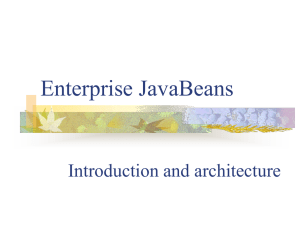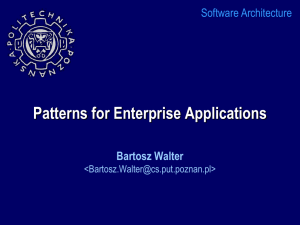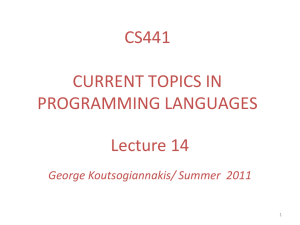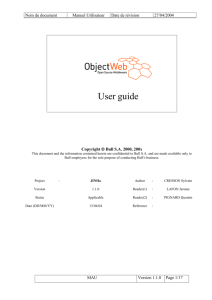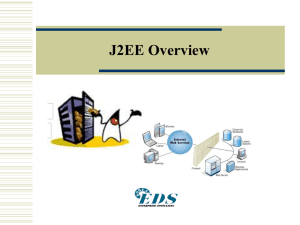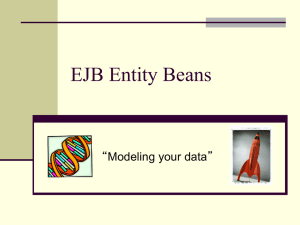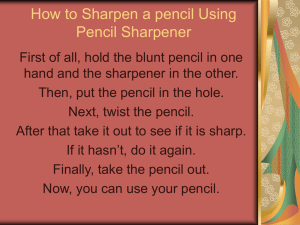lecture (3.* +)
advertisement
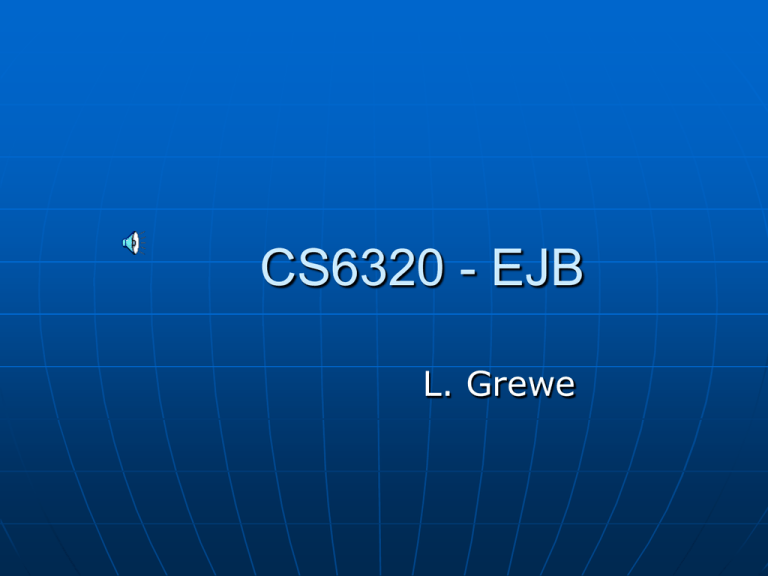
CS6320 - EJB
L. Grewe
Enterprise JavaBeans Components
Enterprise applications are modeled as a collection of
components (or enterprise beans) in which each component
is a reusable software unit that implements a specific part
of the business functionality and has a well-specified
interface.
Used in Business/Data layers
Scalable
• container can create pool of servable EJBs
Transactional
• EJBs can manage transactions
Concurrency safe.
• EJBs can have state protection from concurrent access
• EJBs can be tied with database entries
A Java Architecture
Java Technologies
External
Application
EJB lives in a container
Deployed on EJB servers and are hosted
within containers.
EJB depend on the container for certain
services that can be declaratively
customized at deployment time.
Example J2EE server
Types of EJBs
There are three types of EJBs:
• Session beans – Model task or process
oriented aspects of a business application
• Entity beans – Model persistent enterprise
data** (note: Entity beans being replaced by
Java Persistence API)
• Message beans – Model asynchronous
consuming of messages
EJB more….
An EJB is a Java object defining a part of an
application.
Each EJB object implements a remote interface
that it advertises.
The EJB system generates proxy objects (stubs
and skeletons) between the client and the EJB.
Clients use the RMI-IIOP protocol for
communication.
Presence of the proxy objects is transparent to
the clients.
N-Tier Architecture
Using EJB
Presentation Layer
Presentation Logic
Tier Boundary
EJB object
EJB object
EJB object
EJB object
Business Logic Layer
(Application Server)
JDBC
Tier Boundary
Database
Data Layer
7
How a Client Accesses an EJB
1.
2.
3.
Client locates the EJB container
through the JNDI service. (or you
know where it is)
Client finds a reference to the EJB's
interface.
Now with the interface object, the
client invokes methods on the EJB
interface which the container in turn
delegates to the bean itself.
Acquiring a Bean
3: Create
Interface
New EJB object
Client
Object
5: Return EJB
Object Reference
6: Invoke
Remote Interface
Business method
1: retrieve
Home Object
Reference
2: Return
Home Reference
4: Create EJB
Object
EJB Object
Enterprise
Beans
7: Delegate request to object
JNDI
EJB Server
Naming
Service
9
The EJB RMI-IIOP
Common Object Request Broker Architecture
(CORBA)
• Specifications governed by the Object Management Group
(OMG)
• CORBA is language neutral, using interfaces written in
Interface Definition Language (IDL).
• CORBA uses Object Request Brokers (ORBs) for networking
and data marshalling.
EJBs borrow heavily from this technology and from
RMI
• RMI-IIOP
CORBA services incorporated into EJBs:
• Naming, Lifecycle management, Security
• Persistence, Distributed structures
Session EJBs
Encapsulate business logic
best practice: use when only one client
has access to a bean instance and the
state does not need to be persistent.
Think of a session bean as a grouping of
related business operations
• BankTeller session bean does withdrawl,
checkaccount, deposit
• LoanManager session bean does
loan_application, loan_approval
Session EJBs: 2 kinds
Stateless
created with no
regard for the
maintenance of any
state between
subsequent calls by a
client.
Statefull
maintain state for a
particular client
between alss before
some amount of time
has expiered.
EJB 3.0 – life made easier
MAJOR changes from 2.* to make
writing EJBs easier
Ease of Use:
• Have replaced 2 interfaces and 1 class
with now only a business interface and a
bean that implements this interface
(note for local access only need class)
Get rid of / simplify deployment XML
files
• Uses 'annotations' rather than the
complex 'deployment descriptors' used
in version 2.x.
EJB 3.* : The interface class
This class defines the business logic
as an interface
package helloworld;
/**
* Interface of the HelloWorld example.
* @author You
*/
public interface HelloWorldInterface {
/**
* Hello world.
*/
void helloWorld();
}
EJB 3.* : The bean
class…implementing the interface
This bean will be a
stateless session bean,
thus the class will be
annotated with @Stateless
annotation.
package helloword;
import javax.ejb.Remote;
import javax.ejb.Stateless;
/**
the interface must be a
* Business code for the HelloWorld interface.
remote interface to be
* @author Florent Benoit
available for remote
*/
clients. This is done
@Stateless
by using the @Remote
@Remote(HelloWorldInterface.class)
annotation.
public class HelloWorldBean implements HelloWorldInterface {
/**
* Hello world implementation.
*/
public void helloWorld() {
System.out.println("Hello world !");
}
}
EJB 3.*: next step of hello world
Compile HelloWorldInterface and
HelloWorldBean
Now you can JAR these files and
deploy (see your container for
details)
EJB 3.*: HelloWorld Client Code
package helloworld;
import javax.naming.Context;
import javax.naming.InitialContext;
/**
* Client of the helloworld bean.
* @author You
*/
public final class Client {
/**
* JNDI name of the bean.
*/
private static final String JNDI_NAME =
"helloworld.HelloWorldBean"
+ "_" + HelloWorldInterface.class.getName() + "@Remote“;
/**
* Utility class. No public constructor
*/
private Client() {
}
You need a client
Could be a servlet
or any kind of Java
program to
communicate with
the EJB. Here we
make a standalone
Console application
Class named Client
//hardcoding location of EJB
//that is in same source package
// as this client
HelloWorld Client
Code…continued You need a client
/**
* Main method.
* @param args the arguments (not required)
* @throws Exception if exception is found.
*/
public static void main(final String[] args) throws Exception {
//grab content of container
Context initialContext = new InitialContext();
Could be a servlet
or any kind of Java
program to
communicate with
the EJB. Here we
make a standalone
Console application
Class named Client.
//look up EJB in this container and grab interface object
HelloWorldInterface businessItf =
(HelloWorldInterface) initialContext.lookup(JNDI_NAME);
System.out.println("Calling helloWorld method...");
//call method of bean remotely through client’s interface object.
businessItf.helloWorld();
}
}
Remote and Local Interfaces
EJB can have remote or local interface
Remote
• Used for accessing beans outside the JVM managing the
bean class
• Restricts access to pass by value, and parameters must
be Serializable
Local
•
•
•
•
Used by clients that share a JVM with the bean
Do not involve networking
Use pass by reference semantics
Allow association with other EJBs (in the local JVM, thus
reduce communication overheads)
• Do not need interface class – can do only with bean
class.
@Remote – an annotation
The @Remote line is an annotation
• It can occur on the previous line, or you can use it like a
modifier (e.g. @Remote public …)
• Annotations specify meta-data
• In this case, @Remote says that the interface can be used
remotely
• Alternatively, a local interface could be used when clients and
EJBs are co-located.
@Local – an annotation
the @Local annotation would declare it as
a local interface, which can only be
accessed from the same machine
EJB 3.* - Another Example
Calculator – add and subtract
import javax.ejb.Remote;
import javax.ejb.Stateless;
@Remote public interface Calculator {
public int add(int x, int y);
public int subtract(int x, int y);
}
@Stateless public class CalculatorBean implements Calculator {
public int add(int x, int y) {
return x + y;
}
public int subtract(int x, int y) {
Return x – y;
}
}
EJB 3.* - Shopping cart - stateful
Still homeless
• Created as they are looked up
@Remove replaces EJBObject.remove in EJB 2.*
when the EJB is to go away.
Stateful bean is removed after method called
import javax.ejb.Remote;
import javax.ejb.Statefull;
@Remote public interface ShoppingCart {
public void addItem(int prodId, int quantity);
public void checkout();
}
@Stateful public class ShoppingCartBean implements ShoppingCart {
@Remove
public void checkout() {
…
}
}
It is called
@Remove annotation – lifecycle end
declares a method to represent the
deletion of the bean
• The method itself does not implement the deletion of the
bean
• The method is called first, then the container deletes the
bean
• This annotation is available to both types of session
bean, as well as message-driven beans
public ShopperImpl implements Shopper {
//… other methods …
@Remove
public void remove() {
System.out.println(“Removing Shopper”);
}
}
EJB – transaction and security
Example Shopping cart –need in
check out
@Stateful public class ShoppingCartBean implements ShoppingCart {
@Remove
@TransactionAttribute(REQUIRED)
@MethodPermission({“valid_customer”})
public void checkout() {
… // your code goes here.
}
}
EJB 3.0: Dependency Injection
Bean class specifies dependencies instead of lookup
The @EJB annotation
Facilitates Test Driven Development
marks the converter
Possible to test EJBs outside of container
field as a dependency
injected field
@Stateful public class ShoppingCartBean implements ShoppingCart {
Dependency injection
is a technical term
that basically means
@Resource private SessionContext ctx;
that dependencies
(such as an EJB to its
client) are made
@EJB
externally
private CreditCardProcessor processor; //specifies EJB that this bean uses.
private DataSource jdbc;
@Resource(mappedName=“java:/DefaultDS”)
public void setDataSource(DataSource db) { this.jdbc = db; }
}
In EJB 3.0, you
can declare which
EJBs should be
used by a
particular when
you deploy that
client
@EJB – dependency injection
You can use the dependency
injection method of obtaining a
session bean instance
• This is the preferred method, since:
It involves less code in the client
It saves the client from dealing with JNDI directly
The javax.ejb.EJB annotation is added to the declaration of
the private member variable shopper, which is of type
ShopperBean. ShopperBean exposes a local, no-interface
view, so the enterprise bean implementation class is the
variable type.
import javax.ejb.EJB;
public class SFSBClient {
@EJB ShopperBean shopper;
}
public void cartTest() {
CartItem item1 = new CartItem(“Briefcase 14x8”, 1);
CartItem item2 = new CartItem(“Ball Point Pen”, 12);
shopper.addToShoppingCart(item1);
shopper.addToShoppingCart(item2);
… code omitted …
}
Lifecycle Annotations / callbacks
PUT THESE METHODS in YOUR BEAN
@PrePassivate
//called before put to “sleep”
public void passivateHandler() {
// free up resources before going into passive mode
// whatever code you want
}
@PostActivate
//called after activated
public void activateHandler(InvocationContext context) {
// re-acquire resources
// whatever code you want
}
NOTE: an alternative to having code in the bean itself is
to create an Inceptor Class ---see later in lecture
Passivate / Activate – Lifecycle modes
As stateful session bean becomes passive, it goes
into an available pool
• The state is serialized and stored to disk
When the bean’s client invokes one of the bean’s
methods, the bean is activated again
• However, if the bean remains unused for too
long, it may be deleted
• In these cases, the container may create a
new instance, and load the state into the new
bean for the client
EJB 3.* Deployment Descriptor.....they
can be optional (but see container for
details)
Some people like XML deployment
descriptors
Externalize configuration
Externalize system architecture
Replace annotations with XML (this is how
must do in EJB 2.*)
Recall Shopping Cart Example
w/ annotations
@Remote public interface ShoppingCart {
public void addItem(int prodId, int quantity);
public void checkout();
}
@Stateful public class ShoppingCartBean implements ShoppingCart {
@Remove
@TransactionAttribute(REQUIRED)
@MethodPermission({“valid_customer”})
public void checkout() {
…
}
Shopping cart with no annotations but
mandatory deployment XML file
public interface ShoppingCart {
public void addItem(int prodId, int quantity);
public void checkout();
}
public class ShoppingCartBean implements ShoppingCart {
public void checkout() {
…
}
}
XML Descriptors
Partial deployment descriptors
supported
• Start off with annotations, configure as needed
<ejb-jar>
<enterprise-beans>
<session>
<ejb-name>ShoppingCartBean</ejb-name>
<ejb-local-ref>
<ejb-ref-name>processor</ejb-ref-name>
<local>CreditCardProcessor</local>
</ejb-local-ref>
</session>
</enterprise-beans>
</ejb-jar>
Interceptors
Interceptors
cart.buy(product)
interceptor
@Stateless
public class CartBean {
public void buy(…) {}
}
Interceptors intercept calls
Interceptors sit between caller and a
session bean
Analogous to servlet filters
Can only be used with session and
message driven beans
Precursor to full aspect-oriented
programming
Interceptors
Interceptor is a plain Java class
A method can be designated as the interceptor method
@AroundInvoke
That method must return Object and throw Throwable
That method must also accept an InvocationContext
InvocationContext hold information about the request
Request can be aborted with an exception
Exceptions can be caught from the bean class and suppressed
Return objects can be changed
Arguments can be modified
Interceptors
public class RuleBasedSecurityInterceptor {
boolean checkRule(…) { …}
@AroundInvoke
//this is the method acting as inceptor
public Object customSecurity(InvocationContext ctx) throws Exception {
if (checkRule(…) == false) {
throw new SecurityException(“Custom check failed”);
}
return ctx.proceed();
}
}
Interceptors
@Stateful
All methods in class
@Interceptors(RuleBasedSecurityInterceptor.class)
public class ShoppingCartBean implements ShoppingCart {
void buy(…) { …}
@Interceptors(RuleBasedSecurityInterceptor.class)
public void checkout() {…}
}
Per method
Default Interceptors
<ejb-jar>
<assembly-descriptor>
<interceptor-binding>
<ejb-name>*</ejb-name>
Every bean in deployment
<interceptor-class>org.jboss.RuleBasedSecurity</interceptorclass>
</interceptor-binding>
</assembly-descriptor>
</ejb-jar>
Intercepting callbacks
POST CONSTRUCT EVENT
Interceptor
@Stateful
public class CartBean {
@PostConstruct
public void initialize(…) {}
}
Callback events can be intercepted
Work same as @AroundInvokes
Intercepting Callbacks
@Stateless
@Interceptor(JndiInjector.class)
public class JndiInjector {
@JndiInject(“java:/TransactionManager”)
TransactionManager tm;
}
Custom injection annotation
Intercepting Callbacks
public class JndiInjector {
@PostConstruct
public void injector(InvocationContext ctx) {
injectIntoAllFieldsWithJndiInjectAnnotation(ctx.getTarget());
}
}
EJB 2.* ---for historical
purposes
Need 2 interfaces and 1 class
EJB 2.*: Back to Classes: Home
Interface
Implements EJBHome
Lists methods available for creating, removing and finding EJBs in the
container.
container creates a home object from this interface at deployment time.
at runtime home object used by client in conjunction with a naming
service to find the component and establish a connection to its
component interface
public interface EnrollmentCartHome extends EJBHome {
EnrollmentCart create () throws CreateException,RemoteException;
}
EJB 2.*: Back to Classes:
Component Interface
defines the methods offered by the bean class.
container provides implementation of this interface by creating an
object
client through the home object (see above) is given this component
object and uses it to invoke methods on the bean.
component interface can be remote OR local.... remote when EJB client
on different machine (typical) otherwise local (sometimes).
public interface EnrollmentCart extends EJBObject {
public void addCourses(String[] courseIDs) throws RemoteException;
public Collection getCourses() throws RemoteException;
public void empty() throws RemoteException;
}
EJB 2.*Back to Classes: Bean Class
has methods that implements business logic,etc.
accessed by client through component object (see above) not directly.
public class EnrollmentCartEJB implements javax.ejb.SessionBean {
private SessionContext ctx;
private HashSet cart;
/* callback methods */
public void setSessionContext(SessionContext ctx) {
this.ctx = ctx; }
pubic void ejbCreate() throws CreateException {
cart = new HasSet(); }
public void ejbActivate() {}
public void ejbPassivate() {}
public void ejbRemove() {}
/* implement all business methods as defined in the component interface*/
public void addCourses(String[] courseIds) {
if(couseIds == null)
return;
for(int i=0; i<courseIDs.length; i++)
cart.add(courseIds[i]);
}
public Collection getCourses() {
return cart; }
public void empty() {
cart.clear(); }
}
Development Steps (similar for
EJB2.* and EJB3.*)
Implement EJB Standard
Interfaces Interfaces required by
standard EJB component model to
enable container-based management
of EJB
Implement EJB Business-Specific
Interfaces (bean class)
• Any business-specific interfaces (usually
in session beans) and any supporting
helper and utility classes.
Development Steps
Create Client Remote Interfaces
• (component interface)
• remote interface for your EJBs that
define all of the business-specific
interfaces (usually session beans)
Create Client Home Interfaces
• (home interface)
• Home interface for your EJB that defines
application-specific methods for creating
your EJB as well as for finding your
entinty EJBs.
Development Steps
Compile EJB Code
• Compile: EJB implementation, home
interface, remote interface.
Deployment Descriptor
• create for deployment of your EJBs
• specifies:
• EJB type, transaction attributes,
security attributes.
• ejb-jar.xml
Development Steps
Application Deployment
Descriptor
• May be Optional, but, if grouped into
modules will need (i.e. sun-ejb-jar.xml)
Development Steps
Package EJBs into EJB Jar
module
• * May be Optional but, a good idea.
Application Deployment
Descriptor
• May be Optional, but, if grouped into
modules will need (i.e. sun-ejb-jar.xml)
Development Steps
Package EJB Modules into one
J2EE EAR Application
• May be Optional but, good idea when
have multiple modules
Deploy the Application
• Deploy to container using descriptor(s).
Alternative Deployment
Can Deploy as part of a Web
Application – with other items like
Servlets, etc.
Enterprise beans often provide the business logic of a web
application….hence packaging them within the web application's
WAR (web application archive) module simplifies deployment and
application organization. Enterprise beans may be packaged
within a WAR module as Java programming language class files or
within a JAR file that is bundled within the WAR module.
To include enterprise bean class files in a WAR module, the class
files should be in the WEB-INF/classes directory.
To include a JAR file that contains enterprise beans in a WAR
module, add the JAR to the WEB-INF/lib directory of the WAR
module.
Glashfish Server and EJB and other code
Deployment
Descriptor
Container
Specific
Descriptor
EAR files option
Tools to Deploy
Use container provided Tools
Sometimes can deploy from IDEs
and other tools
Example for Glashfish:
Administration Console (container)
The asadmin Utility (container)
Ant Utility (container)
NetBeans IDE
Eclipse IDE (In addition to the bundled NetBeans IDE, a plug-in for
the Eclipse IDE extends GlassFish to the Eclipse community. To download,
see https://glassfishplugins.dev.java.net/.)
JSR 88 Client
Client Code – using an EJB
1. Grab Context object that acts as a
"handle" to the EJB Container (use
JNDI service)
see here for details
Using JNDI to lookup EJB on same J2EE app
the initial context factory used is ApplicationClientInitialContextFactory.
References to the remote objects that are part of the application are specified in
application-client.xml and orion-application-client.xml files located in Meta-Inf
directory of the application ear file. The context factory reads these files when
accessing the remote object.
The reference to the EJB object in application-client.xml file is specified like this
Using the ApplicationClientInitialContextFactory to construct JNDI initial contexts
allows the client to look up local objects (objects contained in the immediate
application, or in its parent application) using the java:comp/env mechanism.
Remote objects can be looked up using ORMI.
Using JNDI to lookup EJB on same J2EE app
//Code to look up an EJB object is part of the same J2EE application
import java.sql.Connection;
import javax.naming.InitialContext;
import javax.naming.Context;
import javax.sql.DataSource;
//Note :This code assumes EJBHomeInterface and EJBRemoteInterface already exist
public class Code1{
public Code1(){
Hashtable env = new Hashtable(); // set the environment properties.. Yours will be different
env.put(Context.INITIAL_CONTEXT_FACTORY,"com.evermind.server.ApplicationClientInitialContextFactory");
env.put(Context.PROVIDER_URL, "ormi:///ejbsample");
env.put(Context.SECURITY_PRINCIPAL, "admin");
env.put(Context.SECURITY_CREDENTIALS, "welcome");
try { // create an initial context using the above environment properties
Context context = new InitialContext(env);
EJBRemoteInterface ejbObject;
// Perform look up using JNDI name of ejb object
Object boundObject = context.lookup("ObjectName"); //this should be name of EJB object
// Narrow the reference of the object returned by lookup() method
EJBHomeInterface homeInterface = (EJBHomeInterface)PortableRemoteObject.narrow( boundObject,
EJBHomeInterface.class);
// create an EJB instance
ejbObject =homeInterface.create();
} catch (NamingException e) { System.out.println(e.toString()); }
}}
Client Code – usng JNDI to lookup EJB not
in same application
Sometimes the application might need to use an object that
is part of another J2EE application. It is also possible that
the EJB object is a part of current application but the
reference to the resource objects cannot be specified or is
not specified in the current application's applicationclient.xml file. In such cases, RMIInitialContextFactory
is used for creating the initial context .
Here is the code to use RMIInitialContextFactory and obtain
EJB instance.
Client Code – using JNDI to bind
import java.util.*;
import java.rmi.*;
import java.io.*;
import javax.naming.*
import.javax.ejb.*;
//this client demonstrates use of JNDI
public class Client{
public static InitialContext ctx;
public static void main(String[] argv) {
try{
print("Conneting to a JNDI service ....");
ctx = new InitialContext();
System.out.print("connected successfully");
//add binding
String name = "mary"; String email="mary@fun.com";
ctx.bind(name, email);
//lookup binding
String s = (String) ctx.lookup("mary");
print(s);
//delete binding
ctx.unbind("mary");
//close
ctx.close();
}catch(CommunicationException e) { //failed to connect}
Client Code – using an EJB
1. Grab Context object that acts as a
"handle" to the EJB Container (use
JNDI service)
2. Use the Context Object to create an
instance of the EJB Home Interface
(A) by looking up the EJB Component
you are looking for.
see here for details
see here for details
EJBHomeInterface A =
ctx.lookup(".../EJBHomeInterface");
3. Create instance of Component
Message Driven Beans..
Message-driven Beans
A message-driven bean (MDB) is
• An asynchronous message consumer
• A MessageListener object on a JMS destination
• Invoked by the container as a result of the
arrival of JMS message
A message-driven bean has no conversational
state
A message-driven bean is anonymous
EJB 3.* : Message Driven
Beans (MDBs)
Just implements MessageListener
Annotation declares as MDB
@MessageDriven( activationConfig={ActivationConfigProperty(name=“destination”,
value=“queue/email”)})
public class EmailBean implements MessageListener {
void onMessage(Message msg) { //whatever code you want }
}
Read online for more
about Message Driven
Beans
Message Driven Beans – another example
import javax.ejb.*;
import javax.jms.*;
@MessageDriven(activationConfig = {
@ActivationConfigProperty(propertyName=“destinationType”, propertyValue=“javax.jms.Topic”)
})
public class NewsletterMailer implements MessageListener {
// This method is declared in MessageListener (a JMS interface)
public void onMessage(Message msg) {
try {
if (msg instance of ObjectMessage) {
ObjectMessage objMessage = (ObjectMessage)msg;
NewsLetter newsletter = (NewsLetter)msg.getObject()
String content = newsletter.getContent();
// send ‘content’ via E-Mail to the newsletter’s subscribers
}
} catch (Exception e) {
e.printStackTrace();
}
}
}
The @MessageDriven annotation marks this class as a MDB
In this case, the MDB will receive events from a topic (i.e.
publish/subscribe type), as opposed to javax.jms.Queue (i.e.
point-to-point message type)
Here, an ObjectMessage is sent, which contains a Java object
MDB: The Client (JMS)
import javax.jms.*;
public class NewsletterClient {
@Resource(mappedName="jms/NewMessageFactory") private ConnectionFactory
connectionFactory;
@Resource(mappedName="jms/NewMessage") private Queue queue;
public void sendNewsLetter(String content) {
NewsLetter newsletter = new NewsLetter(content);
try {
Connection connection = connectionFactory.createConnection();
Session session = connection.createSession(false, Session.AUTO_ACKNOWLEDGE);
MessageProducer messageProducer = session.createProducer(queue);
ObjectMessage objMessage = session.createObjectMessage();
objMessage.setObject(newsletter);
messageProducer.send(objMessage);
messageProducer.close();
} catch (Exception e) {
e.printStackTrace();
}
}
}
The client merely constructs an ObjectMessage, passing it the Newsletter
object, and sends (publishes) it to the message topic
This code is entirely JMS (not EJB at all)
• It is also possible to send the message using another JMS-compatible
messaging system (e.g. IBM WebSphere MQ), using their own API
Entity Beans..
Entity Beans
Used to encapsulate some data contained in the enterprise
system. Such data may be created, removed or found by
clients.
Have special primary key classes defined for them that
relate to primary keys of an associated entity stored in a
database.
Typically do not directly interface between clients to Entity
beans but through middleware of a session bean.
best practice: use if multiple clients can access bean and
state needs to be persistent.
An Entity Bean represents a part of an application.
• A customer name, checking account, etc.
Entity Beans model real-world objects that are persistent.
It is useful to think of an Entity Bean as a representation of
a row in a database.
Entity Bean Features
Entity Beans are transactional.
• Changes to their persistent scope occurs
inside a transactional scope.
• The deployer can specifically turn this
off.
• Transactions are distributed.
Entity Beans can be accessed by
multiple users at the same time.
Entity Beans are persistent.
• They survive server crashes
transparently to the client.
Entity EJBs: 2 kinds
Container Managed
container provides code to deal with insert, delete,
query, update of database. Rely on deployment
descriptor to map EBJ class fields to columns (keys)
of database table. It then generates the SQL as
necessary.
Bean Managed
the bean itself has code to deal with the insert,
deletion, querying and update of data to the relation
data source.
The details
See class materials, reading and api
for details on how to create EJBs
Is a form of distributed computing
and sits on Java’s RMI framework.
More Annotations
@Resource
• Connection factories, env entries,
• UserTransaction, EJBContext, etc.
@EJB
• EJB business (and home) interfaces
@PersistenceContext, @PersistenceUnit
• EntityManager and EntityManagerFactory
@WebServiceRef
• Web service references
@Resource annotation
@Stateless
public class AccountProcessorBean
implements AccountProcessor {
@Resource
protected SessionContext ctx;
public Boolean withdraw(int accountId,Float amount) {
if (!ctx.getCallerPrincipal().getName()
.equals("MikeKeith"))
throw new WithdrawalException(
“All your money has been donated to Mike");
...
}
...
}
@PersistenceContext
@Stateless
public class AccountProcessorBean
implements AccountProcessor {
protected EntityManager em;
public EntityManager getEntityManager() {
return this.em;
}
@PersistenceContext(unitName="Accounts")
public void setEntityManager(EntityManager em) {
this.em = em;
}
public Boolean withdraw(int accountId,Float amount) {
Account acct = em.find(Account.class, accountId);
...
}
...
}

